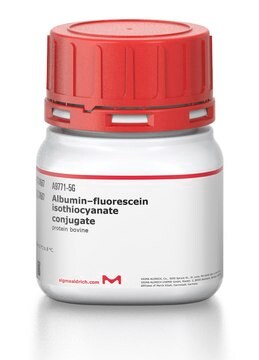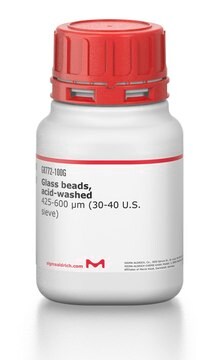R1755
Rhodamine B isothiocyanate
mixed isomers, BioReagent, suitable for protein labeling
Synonym(s):
RBITC
About This Item
Recommended Products
description
labeling efficiency with bovine albumin > 70%
Quality Level
product line
BioReagent
fluorescence
λex 543 nm; λem 580 nm in methanol
suitability
suitable for protein labeling
storage temp.
−20°C
SMILES string
[Cl-].CCN(CC)c1ccc2c(OC3=CC(\C=CC3=C2c4ccc(cc4C(O)=O)N=C=S)=[N+](\CC)CC)c1
InChI
1S/C29H29N3O3S.ClH/c1-5-31(6-2)20-10-13-23-26(16-20)35-27-17-21(32(7-3)8-4)11-14-24(27)28(23)22-12-9-19(30-18-36)15-25(22)29(33)34;/h9-17H,5-8H2,1-4H3;1H
InChI key
YVSWPCCVTYEEHG-UHFFFAOYSA-N
Looking for similar products? Visit Product Comparison Guide
Related Categories
General description
Application
- Rhodamine isothiocyanate labeling
- Rhodamine-labeled synthetic APF
- Preparations of protein and fluorescent conjugates
- Fluorescent red dye
Signal Word
Danger
Hazard Statements
Precautionary Statements
Hazard Classifications
Acute Tox. 4 Dermal - Acute Tox. 4 Inhalation - Acute Tox. 4 Oral - Eye Irrit. 2 - Resp. Sens. 1 - Skin Irrit. 2 - STOT SE 3
Target Organs
Respiratory system
Storage Class Code
11 - Combustible Solids
WGK
WGK 3
Flash Point(F)
Not applicable
Flash Point(C)
Not applicable
Personal Protective Equipment
Choose from one of the most recent versions:
Already Own This Product?
Find documentation for the products that you have recently purchased in the Document Library.
Articles
Nitric oxide (NO) as a signal transporter in neurons, endothelial cells and in the immune system.
Our team of scientists has experience in all areas of research including Life Science, Material Science, Chemical Synthesis, Chromatography, Analytical and many others.
Contact Technical Service





